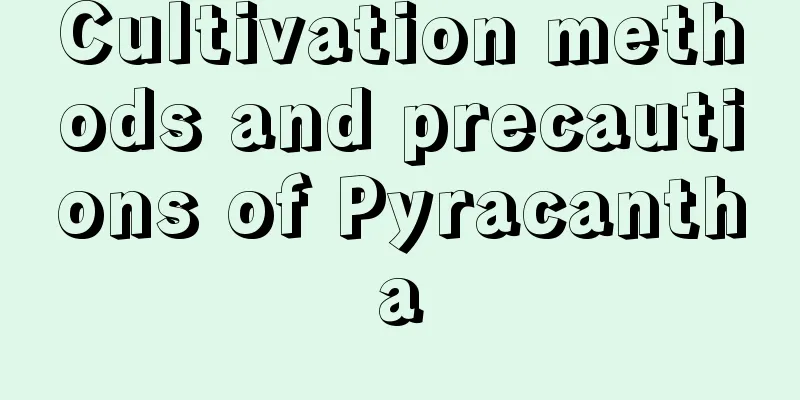Cultivation methods and precautions of Pyracantha

Farming methodsPyracantha likes a warm and humid environment. Pay attention to ventilation at all times, otherwise it will easily cause Pyracantha diseases. Pyracantha grows best in an environment with a temperature of 20~30°C. It requires sufficient light and should be given a longer sunshine time. Pyracantha is relatively cold-resistant and can easily survive the winter. If the temperature of the environment in which Pyracantha grows is too high in winter, it will affect the flowering and fruiting of Pyracantha in the second year. Pyracantha has low requirements for soil, but in order for the Pyracantha plant to grow well, you should choose sandy soil with a deeper soil layer, looser soil and better drainage for planting. Normally, you can apply some nitrogen fertilizer regularly to promote the growth of Pyracantha branches and leaves. When the flowering period is about to begin, you can apply some phosphorus fertilizer and potassium fertilizer to promote the prosperity of the flowering period and promote the ripening of the fruit. No fertilizer is needed in winter to allow Pyracantha to pass its dormant period. Pyracantha is very drought-resistant, but the soil tends to dry out in winter, so you can water it appropriately. During the flowering period, the soil can be kept relatively dry, which is good for the fruiting of Pyracantha. If the flowering period coincides with the rainy season, pay attention to drainage. After harvesting the fruits and before entering the dormant period, water the plants enough for the winter, and then no watering is required during the dormant period. Pyracantha is generally propagated by two methods: seed propagation and cuttings. PrecautionsWhen planting Pyracantha, we must pay attention to preventing diseases and insect pests of Pyracantha. If Pyracantha is planted in an environment with poor ventilation, it will easily be infected by fungi, causing powdery mildew, leaf spot, rust and other diseases. Therefore, we must maintain ventilation, provide Pyracantha plants with sufficient light, and spray them with medicines such as Benomyl in time when the disease occurs. Aphids are more likely to appear in spring, and Pyracantha is also prone to pests such as the pear-crowned bug. We must discover them early and apply relevant pesticides as soon as possible to kill the pests. Pyracantha also needs pruning, because the crown of Pyracantha is very messy in its natural state, which not only affects the growth of Pyracantha, but also affects the results of Pyracantha, so we have to prune overly dense branches, overgrown branches, thin branches, etc. every year. When the flowering period is approaching, be sure to prune branches with too many flower buds. Pyracantha is very fond of water and fertilizer, so the soil of potted Pyracantha should be changed and the pot should be repotted every two years to maintain the fertility of the potting soil. |
<<: These large green plants with great meanings must have a pot at home
Recommend
Causes and treatments for yellow leaves of mountain roses
1. Too much watering 1. Reason: Mountain rose is ...
How to remove freckles with garlic
1. Freckle removal method 1. Peel and clean the g...
4 ways to germinate aloe queen seeds
Aloe Queen Refrigerator Storage Germination Place...
How to grow ginseng fig and make its roots grow bigger?
1. Breeding methods 1. Light: It likes light and ...
Why Strelitzia Reginae Doesn't Bloom
If the Strelitzia reginae in your home is slow to ...
How often should I water Dendrobium candidum?
How often should I water Dendrobium candidum? Den...
How and when to grow petunia
Petunia is a very beautiful flower with rich colo...
How and when to plant daisy seeds: soak for several hours before sowing
To harvest daisy seeds, you have to wait until th...
How to propagate mulberry trees by cuttings
Material selection Cuttings are usually taken in ...
Grow these 18 kinds of succulents in spring, and you’ll have great fortune, luck in love, and lots of good luck!
Peach Egg Of course, peach blossoms are indispens...
What are the cultivation methods and precautions of hydrangea?
Hydrangea cultivation method Hydrangea prefers a ...
What are the cultivation methods and precautions for bicolor jasmine?
Introduction of Bicolor Jasmine Bicolor jasmine, ...
After 15 years of cultivation, the asparagus fern has grown wildly to 20 meters and covered the entire wall!
Buddhist flower cultivation: asparagus fern grows...
How often should you water your orchid?
How often should you water your orchid? As the sa...
How to grow Cordyceps sinensis
soil Cordyceps should be grown in loose, fertile,...









